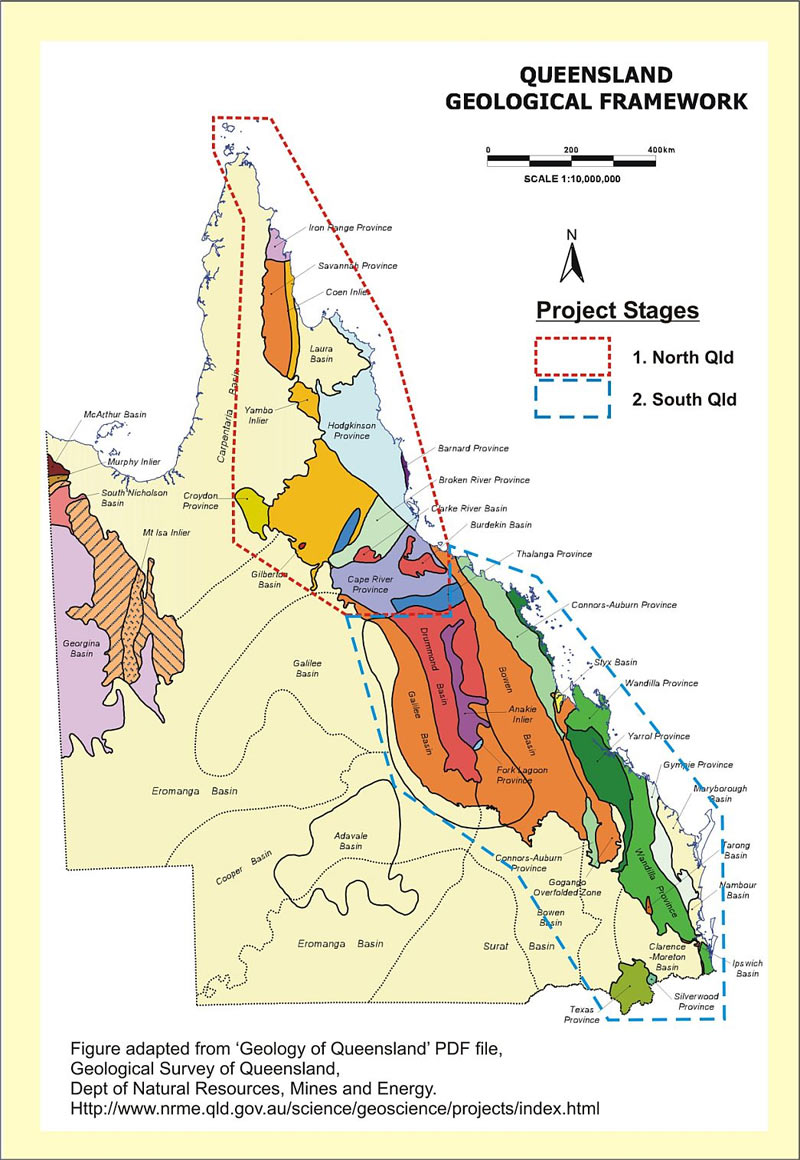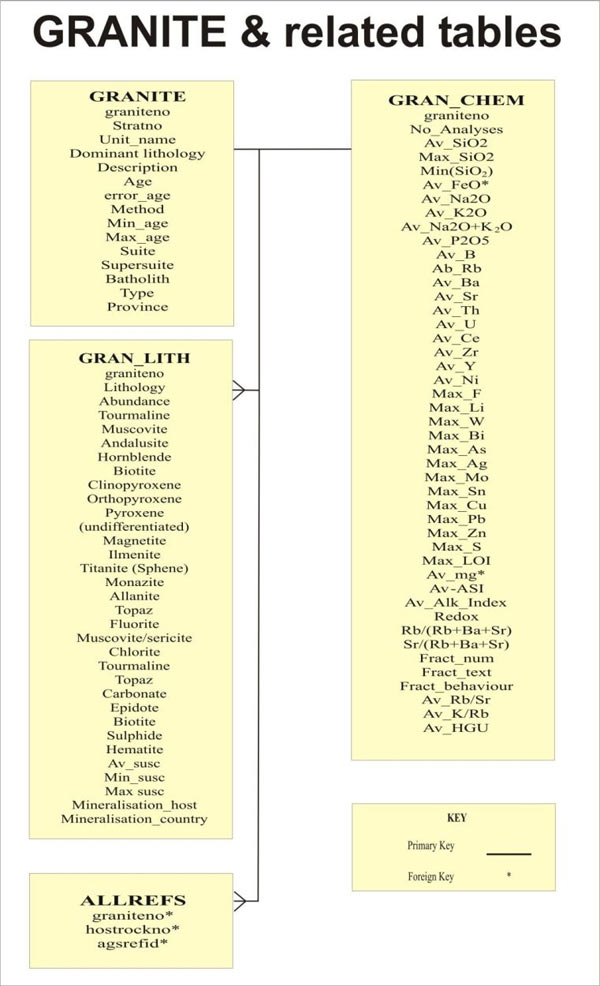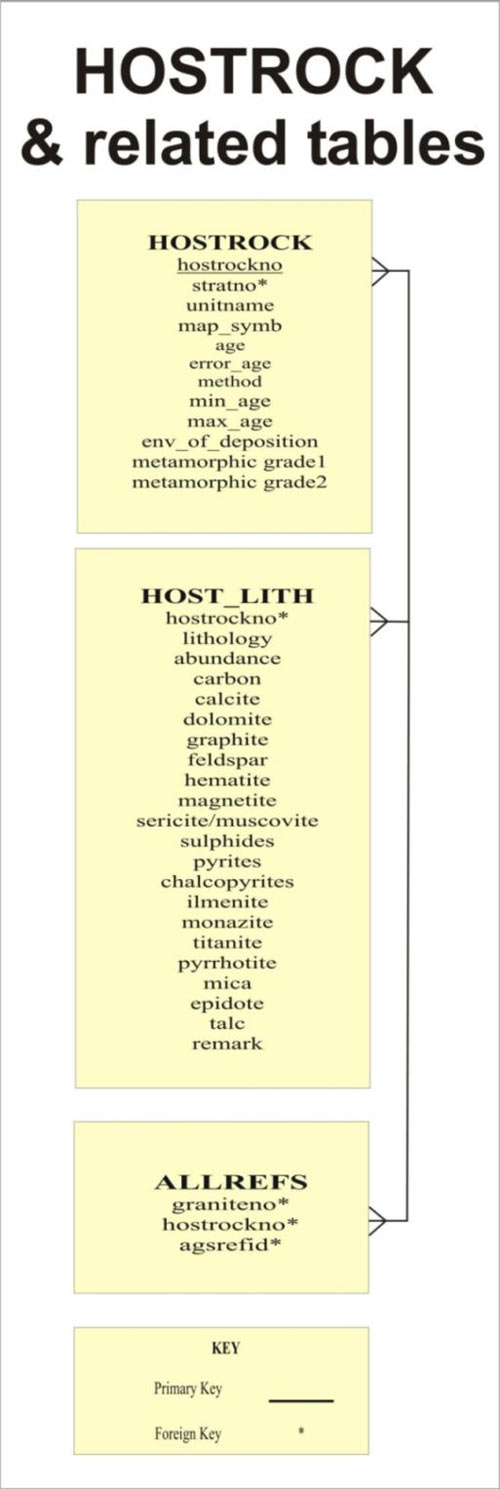Felsic and Intermediate Igneous Rocks of Australia Project
Page last updated:8 April 2016
This project concluded 30 June 2007.
Project description
Geoscience Australia, in collaboration with the Geological Surveys, Mineral Resources Tasmania and Phil Blevin of Petrochem Consultants, started a project in 2003 focussed on the Tasmanides of eastern Australia. The project aimed to provide a synthesis of publicly available data sets to assess the metallogenic potential of major Australian Phanerozoic granite suites and their associated host rocks. These datasets were considered to be key ingredients for better definition and targeting of potential granite related gold based mineralisation in brownfield and greenfield areas of eastern Australia. Use of such data is important for explorers investigating new deposit styles, in particular the intrusion-related gold model.
Project technical notes
Rationale
A significant proportion of the mineral endowment of eastern Australia is associated with Phanerozoic granites and comagmatic volcanic rocks. Accordingly, considerable scientific research and data gathering over the past 15 years has been focussed on these magmatic systems. A major outcome (Blevin and Chappell, 1992) has been the recognition that the nature and style of mineralising systems associated with these felsic rocks, including porphyry copper-gold and copper-molybdenum, vein style tungsten, molybdenum, tin and gold varies with both the mineralogy and chemistry of the related magmatism.
However, it is increasingly recognised that the development of mineralisation is controlled by many factors other than just the chemistry and intensive parameters intrinsic to the magmatic systems. Wall rock controls, such as oxidation state, competency, porosity and structural preparation are considered critical for a fertile system. The mineralogical composition of the host rocks also appears important and certainly plays a significant role in metal precipitation, with the example of many deposits being hosted by rocks rich in reductants such as magnetite, graphite and/or sulphide. Interestingly, empirical data also indicate that deposit types may be host rock specific, with the example of Haynes (2003), Magmas to Mineralisation: The Ishihara Symposium, suggesting iron oxide-copper-gold and porphyry copper deposits are found in settings where host rocks contain little or no reduced carbon minerals such as graphite. Conversely, Wyborn (2003), Magmas to Mineralisation: The Ishihara Symposium, suggests gold only deposits occur where host rocks are carbonaceous.
The potential for host rocks to play a significant role in the mineralising environment is clear, even more so when it is considered that mineralisation may occur up to three kilometres from the granite body. Unfortunately, previous studies of magmatism and associated metallogenesis in eastern Australia have largely ignored country rocks and their role beyond simple criteria such as level of emplacement and level of exhumation.
To address this shortcoming, Geoscience Australia, in collaboration with the relevant State Geological Surveys and Phil Blevin of Petrochem Consultants, initiated a comprehensive data collation and synthesis program on intermediate to felsic intrusive rocks and their associated host rocks. The objectives of this project were:
- to provide a synthesis of publicly-available geochemical and other data on major Australian Phanerozoic granite suites and their associated host rocks, in particular compiling comprehensive intrusive and host rock data sets
- to investigate links between mineralisation styles, specifically potential intrusion related mineralisation, magmatism, and host rock lithologies
- to provide various outputs and products utilising these datasets to illustrate metallogenic analysis and mineral potential of east Australian intrusives.
In addition, the documentation of the spatial and temporal evolution of Australian magmatism through time (Champion and Smithies, 2007) provides an improved framework for understanding the known distribution of mineralisation. This, coupled with similar studies of host rock data, should assist in the prediction and better targeting of mineralised sites for a range of commodities and newly recognised classes of deposits, in particular intrusion related gold deposits Sillitoe and Thompson, (1998), Intrusion-related vein gold deposits: types, tectono-magmatic settings and difficulties of distinction from orogenic gold deposits, and Lang and Baker (2001), Intrusion-related gold systems: the present level of understanding.
Methodology
Methodology for this project was based on previous Geoscience Australia regional studies, Champion and Heinemann (1994), Igneous rocks of northern Queensland: 1:500 000 map and explanatory notes and Budd, Wyborn and Bastrakova (2001), The metallogenic potential of Australian Proterozoic granites and industry sponsored projects (Australian Minerals Industry Research Association (AMIRA) P147B, P425, P426, P515). The igneous unit dataset (GRANITE) includes a wide range of mineralogical, geophysical, geochronological, chemical, metallogenic association and classification (suite, supersuite) data considered necessary to characterise each unit and its metallogenic potential (Table 1). Data collated for the country rock dataset (HOSTROCK) included lithological, mineralogical, geophysical, geochronological and metamorphic parameters (Table 2).
All units, igneous and host rock, were uniquely identified by stratigraphic unit number (STRATNO), which relates to the primary national standard for formal and informal geological names, the Australian Stratigraphic Units Database. Datasets from the project will be linked to any digital dataset which contains STRATNO, independent of scale. The use of the STRATNO identifier also allows links to Geoscience Australia's Surface Geology of Australia 1:1 million scale map and Surface Geology of Australia data package.
Program
The 2003-04 program concentrated on Proterozoic and Phanerozoic granites and associated rocks from the north Queensland region (Figure. 1). This region was chosen for a number of reasons. Firstly, it capitalised on the extensive previous work undertaken in this area (e.g., the various AMIRA projects and studies by Geoscience Australia and the Geological Survey of Queensland), and on a recent comprehensive synthesis of geoscience information for this region, encapsulated in the North Queensland Geology volume (Bain and Draper 1997). Secondly, the region hosts significant mineralisation of various styles, including those interpreted to be intrusion-related gold deposits as illustrated in Baker and Andrew 1991, Geologic, fluid inclusion, and stable isotope studies of the gold-bearing breccia pipe at Kidston, Queensland, Australia. Outputs from this first phase included abstracts, presentations and reports. Initial results from the GRANITE and HOSTROCK datasets were incorporated into the Queensland portion of Geoscience Australia's Surface geology of Australia map and Surface Geology of Australia data package.
In conjunction with Mineral Resources Tasmania and Phil Blevin from Petrochem Consultants, a similar project was undertaken for granites and host rocks of Tasmania. Outputs are available from Mineral Resources Tasmania. All data will be incorporated into the project as they become available.
A similar Phanerozoic granites data collation project is being undertaken in New South Wales by the Geological Survey of New South Wales in collaboration with Phil Blevin. The major focus of the 2004-05 program was the Phanerozoic granites and associated rocks from southern Queensland (Figure. 1). This phase of the project built on new regional geological mapping of this part of Queensland by the Geological Survey of Queensland and the concomitant increase in geological understanding. This resulted in completion of the coverage for Queensland.
The project was rolled into the Phanerozoic Synthesis Project in 2007.
Project outcome
- enhanced understanding of Australia's mineral potential and metallogeny for the promotion of exploration and land use decisions
- increased exploration activity in, and promotion of, the Tasmanides for mineral exploration.
Project outputs
- compiled igneous unit digital dataset (GRANITE) comprising mineralogical, geophysical, geochronological, chemical, metallogenic association and classification (suite, supersuite) data for intrusive units of north Queensland
- compiled country rock digital dataset (HOSTROCK), including lithological, mineralogical, geophysical, geochronological and metamorphic parameters for country rocks of north Queensland
- abstract volume for Magmas to Mineralisation: The Ishihara Symposium, a one day workshop and a two day symposium held from 22 to 24 July 2003 at Macquarie University in Sydney to address research into granites and their associated ore deposits
- online web release of selected presentations from Magmas to Mineralisation: The Ishihara Symposium, a one day workshop and a two day symposium held from 22 to 24 July 2003 at Macquarie University in Sydney
- compiled igneous unit digital dataset (GRANITE) comprising mineralogical, geophysical, geochronological, chemical and metallogenic association and classification (suite, supersuite) data for intrusive units of south Queensland
- compiled country rock digital dataset (HOSTROCK) including lithological, mineralogical, geophysical, geochronological and metamorphic parameters for country rocks of south Queensland
- Intrusion Related Gold Deposits documenting intrusion related gold models, geological characteristics and exploration criteria from the Australian perspective
- a presentation given at Mining 2005, Brisbane, 26 October 2005, on New Insights into Intrusion-related Gold-Copper Systems in the Tasmanides by Dave Champion and Phil Blevin
- a presentation given at Digging Deeper, Brisbane and Townsville, November, 2007, on New insights into intrusion-related mineralisation in the Tasmanides by Dave Champion
- a presentation given at the Sixth International Hutton Symposium, Stellenbosch, South Africa, July 2007, on Three billion years of granite magmatism: Palaeo-Archaean to Permian granites of Australia by Dave Champion and Hugh Smithies.
Previous reports
The metallogenic potential of Australian Proterozoic granites was the result of The Metallogeny of Australian Proterozoic Granites project undertaken in 1996-97 by the then Australian Geological Survey Organisation (AGSO) in collaboration with 20 minerals exploration companies.
The original project was a data-driven exercise which asked:
'Where hydrothermal Au, Cu, Zn, Pb, Sn, W, and Mo mineralisation occurs within five kilometres of the boundaries of Proterozoic granites, are there any specific characteristics of either the granites and/or their host rocks?'
The project compiled data on the mineralogy, geochemistry (around 7500 analyses) and age of Proterozoic granites and felsic volcanics as well as the age and mineralogical composition of sediments within five kilometres of Proterozoic granite boundaries for 20 provinces. The project investigated a spatial association only and was not considered of major importance if the metals came from the granite or had been leached from the country rock by processes associated with granite emplacement.
Igneous rocks of northern Queensland : 1:500 000 map and GIS explanatory notes was the result of a study undertaken in 1992-94 by AGSO in collaboration with Placer Exploration Ltd and the then Queensland Department of Minerals and Energy. The original project was set up to develop a comprehensive Geographic Information System (GIS) package focussed on the igneous rocks of northern Queensland (16.5 to 21 degrees S, 142.0 to 147.75 degrees E) and their metallogenic potential.
The project digitally captured all available geological data (published and unpublished) resulting in a seamless geological coverage, including simplified country rock data and detailed intrusive and extrusive igneous rocks data. The latter included a comprehensive metallogenic classification (age, igneous type, oxidisation state, degree of fractionation and potassium content). Accompanying datasets included geochemistry, and mineral location data.
References
- Blevin, PL and Chappell, BW 1992, 'The role of magma sources, oxidation states and fractionation in determining the granite metallogeny of eastern Australia', Transactions of the Royal Society of Edinburgh: Earth Sciences, 83, pp. 305-316.
- Haynes, DW 2003, 'Are magmas sources of most or all metals in iron oxide-copper-gold and related ore types?', Magmas to Mineralisation: The Ishihara Symposium, Geoscience Australia Record 2003/14, pp. 75-76.
- Wyborn, LAI 2003, 'Assessing the metallogenic potential of Proterozoic granite suites from first principles', Magmas to Mineralisation: The Ishihara Symposium, Geoscience Australia Record 2003/14, pp. 149-154.
- Champion, DC and Heinemann, MA 1994, Igneous rocks of northern Queensland: 1:500 000 map and explanatory notes. Australian Geological Survey Organisation Record 1994/11.
- Budd, AR, Wyborn, LAI, and Bastrakova, IV 2001, The metallogenic potential of Australian Proterozoic granites. Geoscience Australia Record 2001/12.
- Bain, JHC and Draper, JJ 1997, North Queensland Geology, Australian Geological Survey Organisation Bulletin 240, and Queensland Department of Mines and Energy Queensland Geology 9.
- Baker, EM and Andrew, AS 1991, 'Geologic, fluid inclusion, and stable isotope studies of the gold-bearing breccia pipe at Kidston, Queensland, Australia', Economic Geology, 86, 810-830.
- Sillitoe, RH and Thompson, JFH 1998, 'Intrusion-related vein gold deposits: types, tectono-magmatic settings and difficulties of distinction from orogenic gold deposits', Resource Geology, 48, 237-250.
- Lang, JR and Baker, T 2001, 'Intrusion-related gold systems: the present level of understanding', Mineralium Deposita, 36, 477-489.
- Champion, DC and Smithies, RH 2007, 'Three billion years of granite magmatism: Palaeo-Archaean to Permian granites of Australia', Presentation given at the Sixth International Hutton Symposium, Stellenbosch, South Africa, July 2007.


